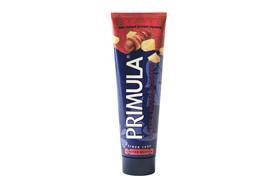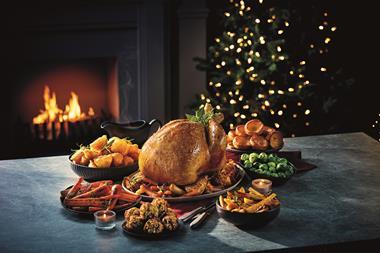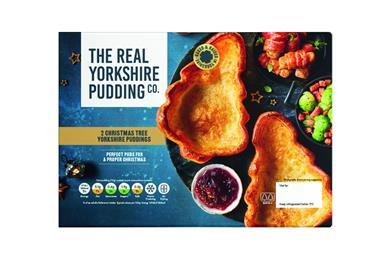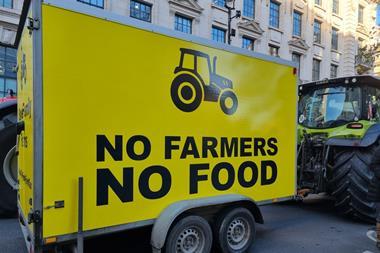Holland’s knows emotional loyalty will be key as it goes national says Siân Harrington
Holland’s pies, puddings and pasties are so well known in the north west that many chip shops in the region list its pies at the top of the menu. In the last Gulf War soldiers were e-mailing the company yearning for pies. Such is its emotional standing that it has its own fan club and customers have even sent poems in about the product.
Yet the 153-year-old Lancashire-based pie maker Walter Holland & Sons is little known outside the region and the challenge that the company has now set itself is to transform it from a strong regional into a strong national brand.
Part of Northern Foods since 1979, Walter Holland produces over 78 million pies each year at its plant in Baxenden, near Accrington and generates a turnover of under £50m.
Some 90% of volume sales are in the north west and the brand has an 80% penetration in foodservice and 60% market share for its frozen pies in retailers within the Granada TV area, with Asda its biggest retail customer. Its frozen and fresh products also sell through Morrisons, Tesco, Sainsbury and Iceland in the region.
Making the transition from regional to national name won’t be straightforward, says sales and marketing director Nigel White. “Regional branding is an effective way for local producers to distinguish themselves from impersonal global companies,” he says, “but rolling your brand outside your heartland and building business with major retailers is not easy.”
But Waitrose’s acquisition of 19 Safeway stores has enabled Holland’s to complete a deal to supply five stores in the north: Sandbach, Harrogate, Southport, Otley and Willerby. It hopes success in these will help convince Waitrose to put the brand into its other stores.
The key to expanding is identifying the brand’s strengths and developing a marketing proposition based on them, says White. For Holland’s, this meant spending last year looking at where the brand was making money and what trends it could tap into. From this analysis, it developed a national strategy based on building its business in retail through better availability and developing closer relationships at store level as well as getting closer to consumers by communicating what the brand means.
“We are working more at store level where the action is,” says White, “and we are picking key customers and consumers we want to work with.
“We cannot be all things to all people. It is important we differentiate, explaining our product value. We could take cost out by not cooking our pies for four hours but that would affect the taste, for example.”
The food trends Holland’s identified are wellbeing, a love for food, convenience, ethical and authenticity (regional and traditional). “We put a big tick next to love for food and authenticity,” explains White. “Consumers who buy these types of products do not want to be marketed to. It is all about how to tell stories.”
So Holland’s has started seeking out the retail environments where, as White puts it, “food lovers go”.
It is considering country shows and events, specialist retailers and foodservice companies as well as bigger retailers that have a ‘food lovers’ proposition. Its deal with Waitrose is the first of these.
To reinforce its baking heritage and expertise, Holland’s has also introduced a new pack design. This uses its traditional red, green and brown corporate colours and has clear colour-coding to help the product stand out on shelf.
The company’s website and fan club are also being promoted on the back of the pack. “We want to be a bit more entrepreneurial and make the most of the high emotional loyalty we engender,” says White. “We believe we can grow through a heavy dollop of word of mouth.”
Holland’s is also looking at the independent market. It has a liveried fleet of 60 lorries making deliveries to chip shops in the north west and believes there are opportunities to use this supply chain to service convenience stores.
“When you are a smaller, regional-based brand you need to find ways to differentiate,” says White.
“My tip to companies looking to grow nationally is not to try to copy the big brands but to concentrate efforts on store level and identify bigger trends to tap into. Smaller companies can move quicker than major brands.”
n Don’t try to copy big boys
n Be different - realise you cannot be all things to all people
n Play on your strengths and pick key retail customers and consumer groups
n Ensure your service levels exceed expectations
n Use the local media in each area you expand into to raise consumer interest
n Concentrate retail efforts on availability and instore execution
How regional can go national
Holland’s pies, puddings and pasties are so well known in the north west that many chip shops in the region list its pies at the top of the menu. In the last Gulf War soldiers were e-mailing the company yearning for pies. Such is its emotional standing that it has its own fan club and customers have even sent poems in about the product.
Yet the 153-year-old Lancashire-based pie maker Walter Holland & Sons is little known outside the region and the challenge that the company has now set itself is to transform it from a strong regional into a strong national brand.
Part of Northern Foods since 1979, Walter Holland produces over 78 million pies each year at its plant in Baxenden, near Accrington and generates a turnover of under £50m.
Some 90% of volume sales are in the north west and the brand has an 80% penetration in foodservice and 60% market share for its frozen pies in retailers within the Granada TV area, with Asda its biggest retail customer. Its frozen and fresh products also sell through Morrisons, Tesco, Sainsbury and Iceland in the region.
Making the transition from regional to national name won’t be straightforward, says sales and marketing director Nigel White. “Regional branding is an effective way for local producers to distinguish themselves from impersonal global companies,” he says, “but rolling your brand outside your heartland and building business with major retailers is not easy.”
But Waitrose’s acquisition of 19 Safeway stores has enabled Holland’s to complete a deal to supply five stores in the north: Sandbach, Harrogate, Southport, Otley and Willerby. It hopes success in these will help convince Waitrose to put the brand into its other stores.
The key to expanding is identifying the brand’s strengths and developing a marketing proposition based on them, says White. For Holland’s, this meant spending last year looking at where the brand was making money and what trends it could tap into. From this analysis, it developed a national strategy based on building its business in retail through better availability and developing closer relationships at store level as well as getting closer to consumers by communicating what the brand means.
“We are working more at store level where the action is,” says White, “and we are picking key customers and consumers we want to work with.
“We cannot be all things to all people. It is important we differentiate, explaining our product value. We could take cost out by not cooking our pies for four hours but that would affect the taste, for example.”
The food trends Holland’s identified are wellbeing, a love for food, convenience, ethical and authenticity (regional and traditional). “We put a big tick next to love for food and authenticity,” explains White. “Consumers who buy these types of products do not want to be marketed to. It is all about how to tell stories.”
So Holland’s has started seeking out the retail environments where, as White puts it, “food lovers go”.
It is considering country shows and events, specialist retailers and foodservice companies as well as bigger retailers that have a ‘food lovers’ proposition. Its deal with Waitrose is the first of these.
To reinforce its baking heritage and expertise, Holland’s has also introduced a new pack design. This uses its traditional red, green and brown corporate colours and has clear colour-coding to help the product stand out on shelf.
The company’s website and fan club are also being promoted on the back of the pack. “We want to be a bit more entrepreneurial and make the most of the high emotional loyalty we engender,” says White. “We believe we can grow through a heavy dollop of word of mouth.”
Holland’s is also looking at the independent market. It has a liveried fleet of 60 lorries making deliveries to chip shops in the north west and believes there are opportunities to use this supply chain to service convenience stores.
“When you are a smaller, regional-based brand you need to find ways to differentiate,” says White.
“My tip to companies looking to grow nationally is not to try to copy the big brands but to concentrate efforts on store level and identify bigger trends to tap into. Smaller companies can move quicker than major brands.”
How regional can go national















No comments yet